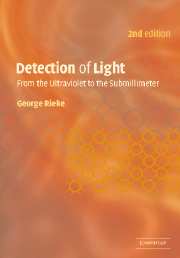Book contents
- Frontmatter
- Contents
- Preface
- 1 Introduction
- 2 Intrinsic photoconductors
- 3 Extrinsic photoconductors
- 4 Photodiodes and other junction-based detectors
- 5 Amplifiers and readouts
- 6 Arrays
- 7 Photoemissive detectors
- 8 Photography
- 9 Bolometers and other thermal detectors
- 10 Visible and infrared coherent receivers
- 11 Submillimeter- and millimeter-wave heterodyne receivers
- 12 Summary
- Appendices
- References
- Index
12 - Summary
Published online by Cambridge University Press: 09 November 2009
- Frontmatter
- Contents
- Preface
- 1 Introduction
- 2 Intrinsic photoconductors
- 3 Extrinsic photoconductors
- 4 Photodiodes and other junction-based detectors
- 5 Amplifiers and readouts
- 6 Arrays
- 7 Photoemissive detectors
- 8 Photography
- 9 Bolometers and other thermal detectors
- 10 Visible and infrared coherent receivers
- 11 Submillimeter- and millimeter-wave heterodyne receivers
- 12 Summary
- Appendices
- References
- Index
Summary
In Chapter 1, we listed three fundamental types of photon detector, and a variety of characteristics that would help define the applications for which a detector is suited. Since then, we have introduced a vast profusion of detectors with a chaotic variety of performance characteristics. We will now return to the basic detector characteristics to examine them in the light of the potential applications of the detectors we have discussed. In comparing different detector systems, a useful figure of merit is the speed, that is, the inverse of the time required for a system to make a given measurement. In selecting a detector system, the general considerations discussed below can be combined with the measurement requirements for a given situation and the characteristics of competing detector systems to estimate relative speeds of these systems, leading to selection of an optimum approach.
Quantum efficiency and noise
Two regimes must be distinguished in discussing the effect of quantum efficiency in choosing a detector: (1) photon noise limited and (2) all other cases. In the first regime, the speed of any incoherent detector is proportional to the detective quantum efficiency. Consequently, detectors with very high DQEs such as bolometers and photodiodes are favored for photon-noise-limited applications.
- Type
- Chapter
- Information
- Detection of LightFrom the Ultraviolet to the Submillimeter, pp. 331 - 337Publisher: Cambridge University PressPrint publication year: 2002



